|
Hanging Plants in
my garden
Taking
stock of my collection and getting them labelled correctly
1
Soleirolia soleirollii -
Baby Tears
|
There are quite a few common names for this plant.
Beside the more commonly used
Baby Tears, there are more names like Corsican Curse, Corsican Carpet plant or even Irish
Moss. Actually Irish moss of course, is a Sagina
The plant is native to the northern Mediterranean region of Italy and the nearby
islands. It was introduced and cultivated world wide as an ornamental plant.
Baby Tear plants are ground creepers, is a
terrariums. Left
by itself, the plant would spread itself to form a dense mat of lush green leaves. Alternatively, if grown in
a pot and then if the pot being hung up, then the stems would form trails. Combined, the
cluster would be looking like a full head of
hairs from hanging basket. |
Baby Tears # 1
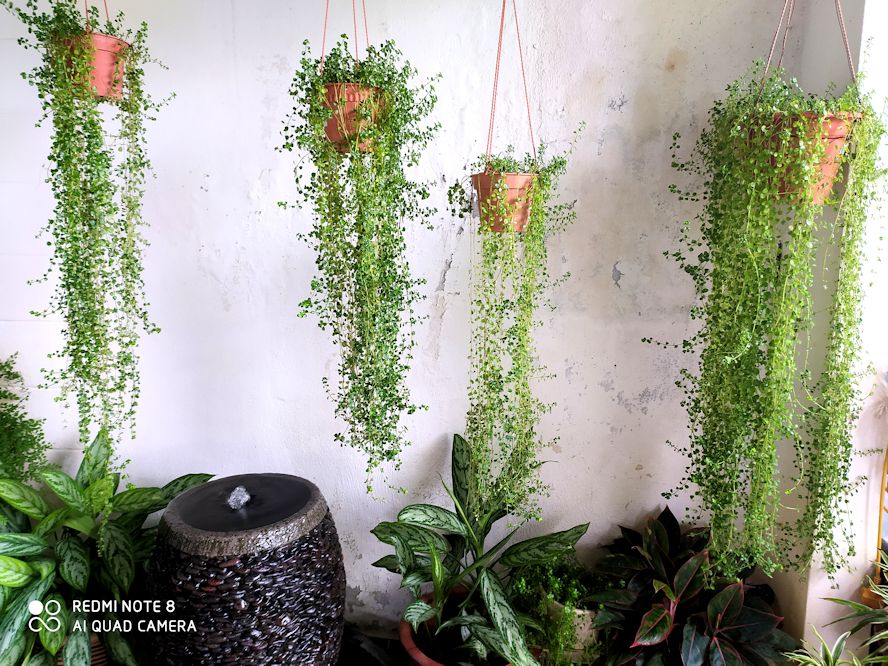
Baby Tears # 1
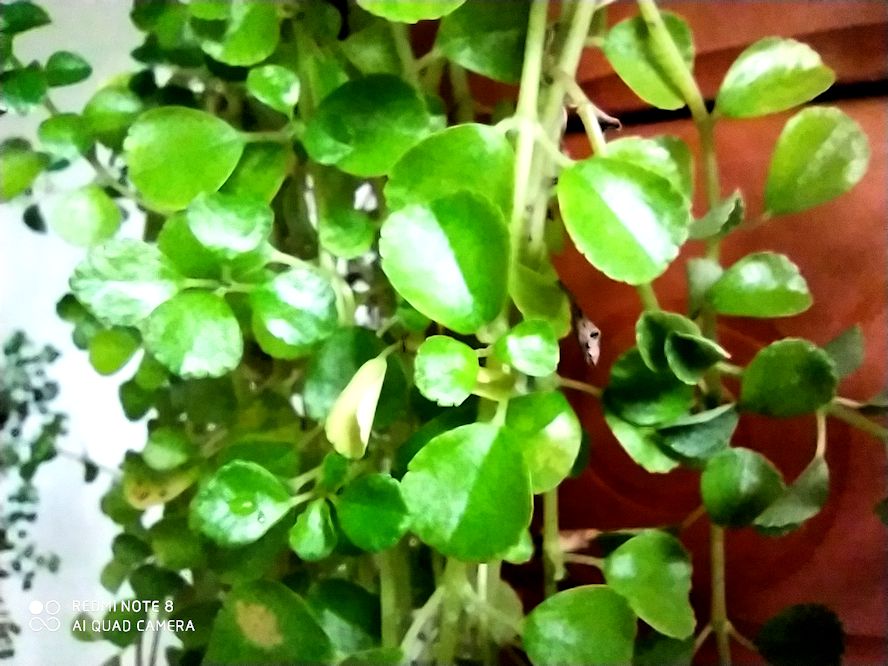
|
A very easy to
maintain plant and elegant looking. The down side - it has low pot life like 4
months. Then it needs replanting |
Pothos or Money Plant
|
Epipremnum aureum is a species in the
arum family Araceae, native to Mo'orea in the Society
Islands of French Polynesia. The species is a popular
houseplant in temperate regions but has also become naturalised in tropical and sub-tropical forests
worldwide, including northern South Africa,
Australia, Southeast Asia, South Asia, the Pacific
Islands and the West Indies, where it has caused severe
ecological damage in some cases.
There are 15 stunning Pothos varieties
that you can grow at home. The term Pothos is used a
little loosely, as many common names are, but it
generally refers to plants in the Epipremnum genus,
particularly the aureum species.
While all Pothos can survive (and some
can even thrive in lower light), they will do better if
attended to and provided sufficient light.
|
2. Epipremnum Aureum -
Golden Pothos -
|
They’re easily identifiable as they have telltale heart-shaped
green leaves that are splashed with golden hues. Also known as
Devil’s Ivy, they’re quite resilient and probably the easiest to
grow of all of the pothos varieties out there. It is arguably the most vigorous and
easiest to grow type. In very mature plants, the leaves
can even grow to 2-3 feet long!
French Polynesia.
In the wild, it often acts as a ground cover, and also rambles up trees. |
Golden Pothos # 1
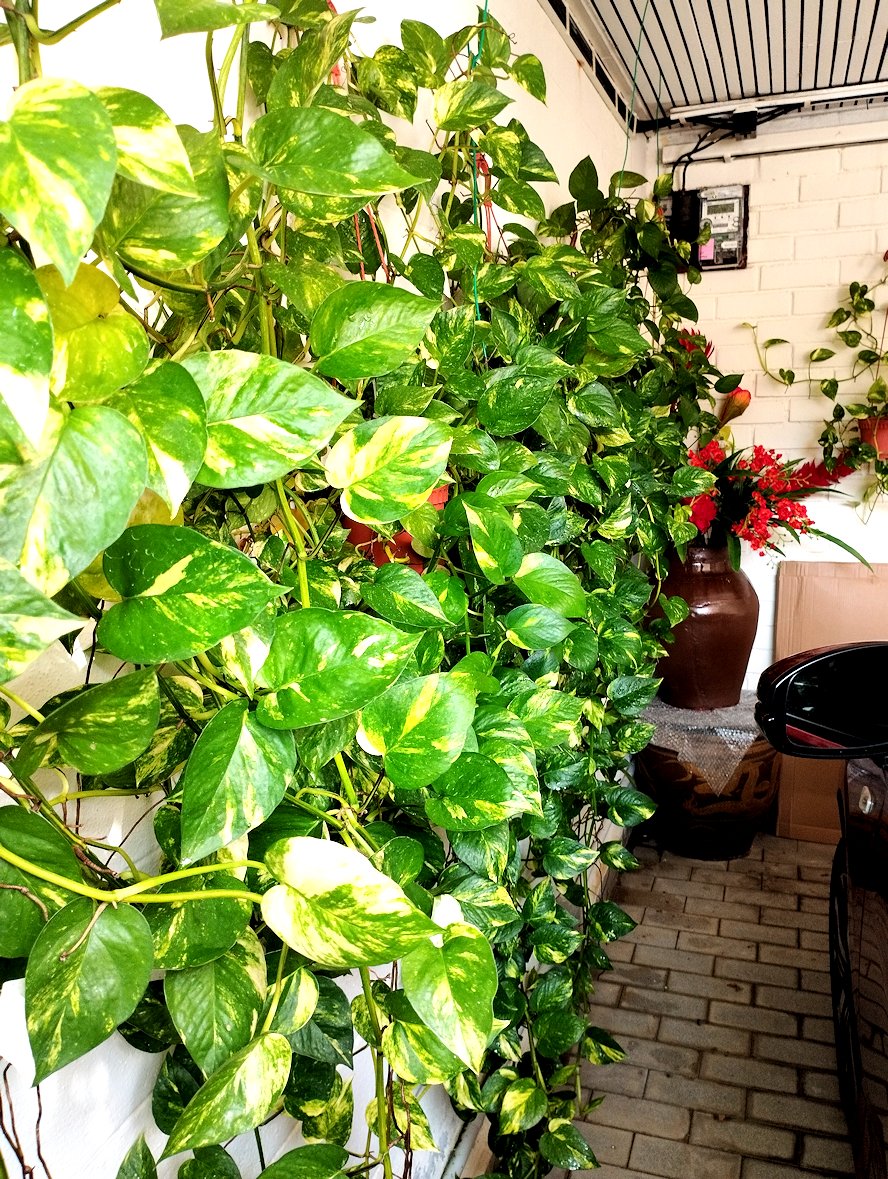
Golden Pothos # 2
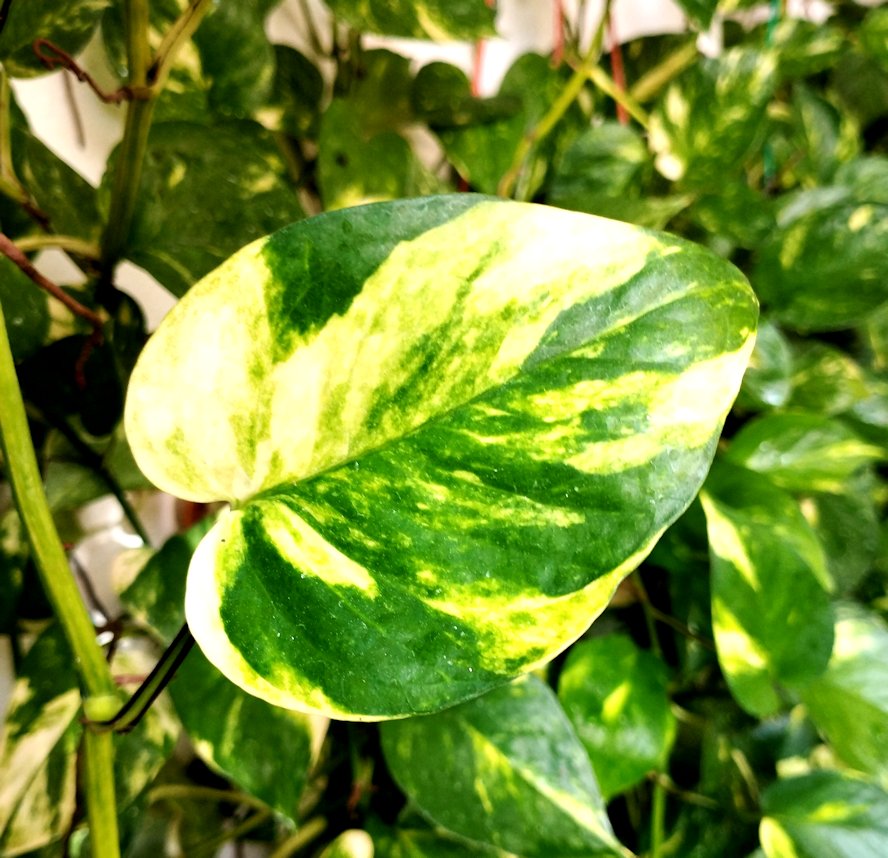
Golden Pothos # 3
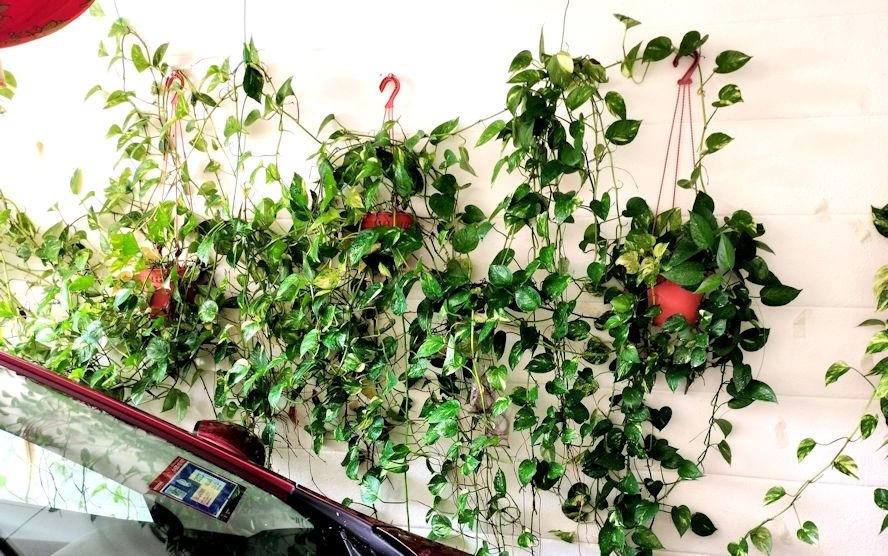
|
This is the common
species in Malaysia selected by gardener, got stale with it and left to grow
like weeds |
3. Epipremnum Aureum -
"Marble Queen"
|
This stunning variety of Pothos has fresh moss-green
leaves and stems that are both streaked in white. Like
any variety of plant that is extremely variegated,
growth will be slower. In general, be sure to give any
highly variegated plants a little more light and avoid
locations that are too dark otherwise growth will be
poor.
The pattern
on the leaves has a ‘cheesecake’ type of look. The white and dark
green are interwoven together kind of like a tapestry or knit
blanket, forming a gorgeous variegation.
They are a highly variegated variety, and as a result will grow
slower as there is less chlorophyll in each leaf. You may want
to move them closer to a light source or windowsill to spur
their growth.
|
Marble Queen
Pothos # 1

Marble
Queen Pothos # 2
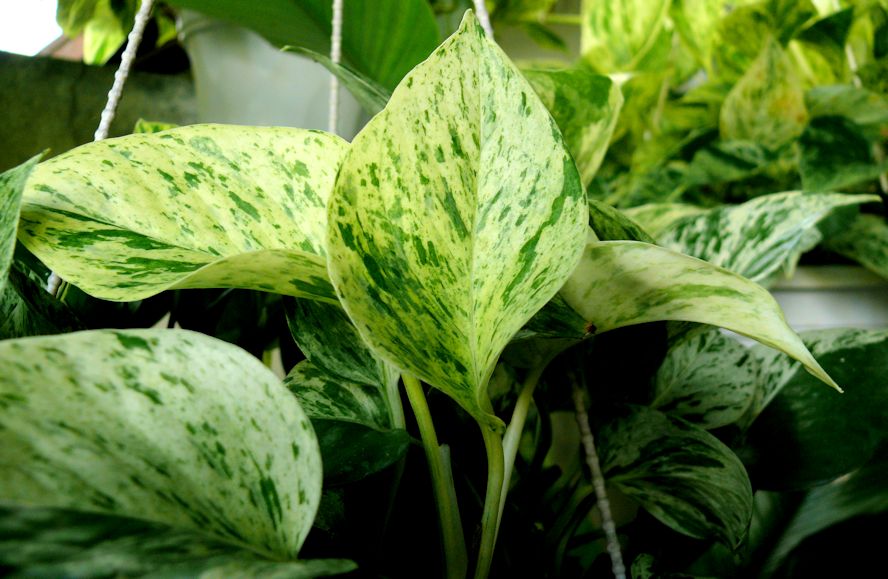
Marble Queen
Pothos # 3

Marble Queen
Pothos # 4
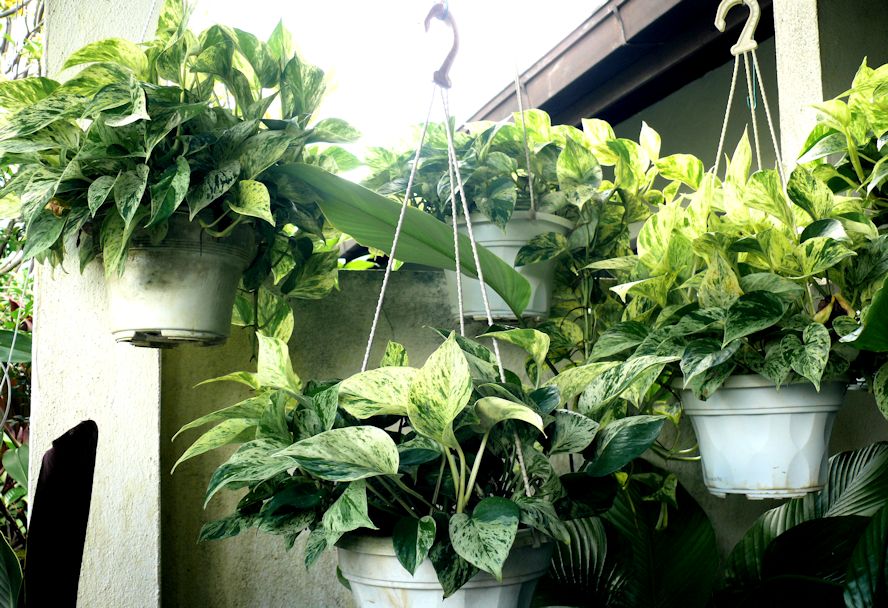
|
Marble Queen is as easy as other Money plant to handle. Grows very well and fast.
Now I am testing to se how large could the leaf grows |
4. Epipremnum Aureum -
"N' Joy"
|
This is one of the newer types of pothos available on the
market. It also has variegated green leaves that are heavily
dappled with white, and the variegation is largely distinct. You
can make the white variegation grow and spread on the foliage if
you keep N-Joy Pothos under bright light.
Pothos N-Joy will be as easy to grow for you as any other type
of pothos. Just keep it near a light source in your home and see
the vine thrive! However, be patient with it since it grows
slowly.
|
N' Joy Pothos
# 1

N' Joy Pothos
# 2
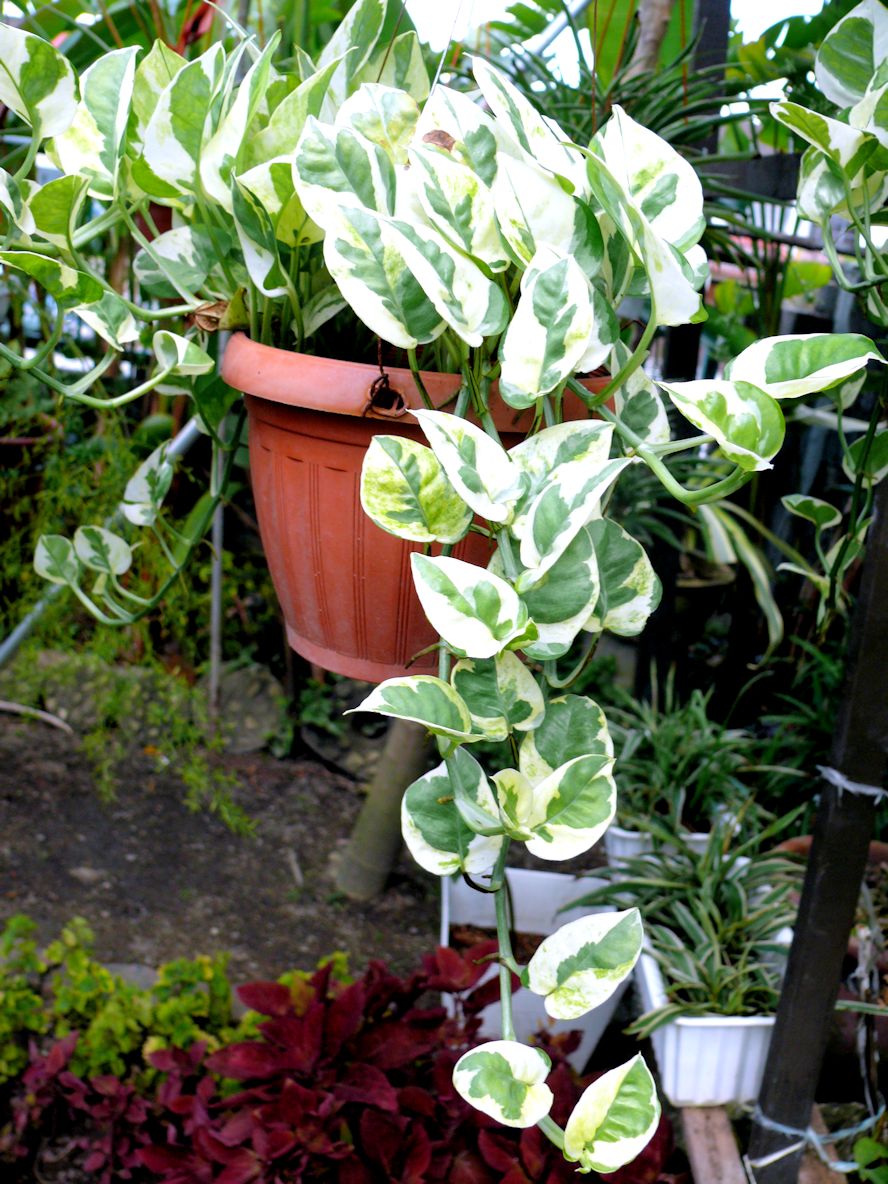
N' Joy Pothos
# 3
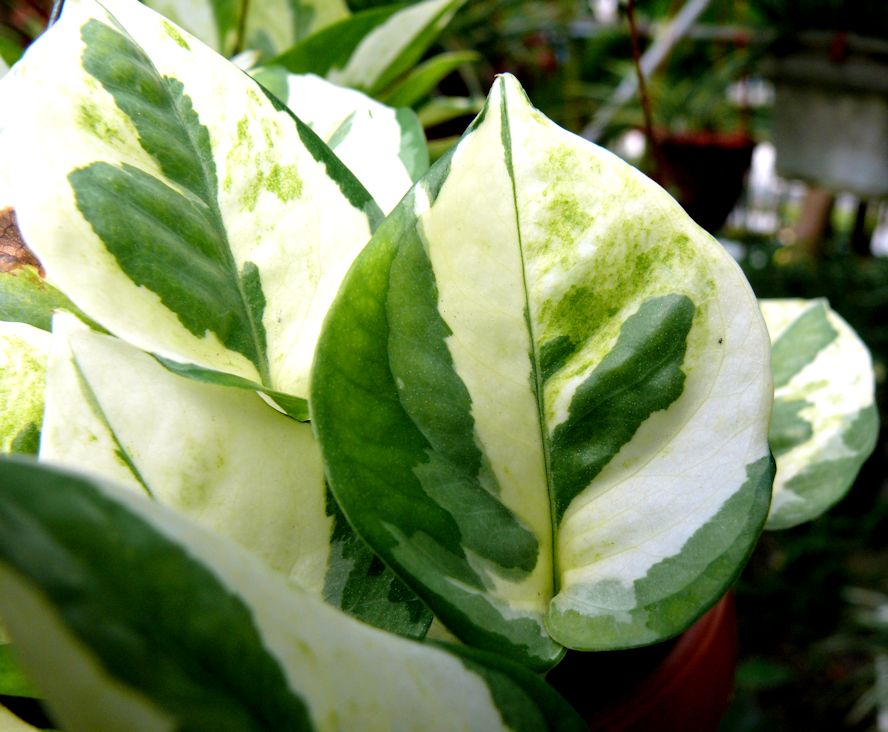
N' Joy Pothos
#

|
Needs lots of sun
and feeding. The leaves are some what smaller and growth is insignificantly
small |
5. Majula Pothos
|
Very similar to Marble Queen, the shape of Manjula
Pothos leaves seem to be wider and rounder. Manjula
leaves have quite a variety of colors including cream,
white green, some silver, and yellow-ish green.
Manjula Pothos is actually a patented variety of pothos, which was
originally produced by the University of Florida. The key
differentiator between Manjula and other types of pothos is that
the heart shaped leaves of Manjula pothos have curvy edges that
refuse to lay flat.
Also, the leaves are variegated with hues of cream, silver,
white, and green. As with other pothos types, your Manjula
pothos leaves will also differ from each other; some will have
large green patches and others will be heavily freckled and
painted with the other hues.
Plus, the variegation of Manjula leaves is not clear cut, so you
can expect specks of green on the whiter areas.
|
Majula Pothos
# 1

Majula Pothos
# 2

Majula Pothos
# 3
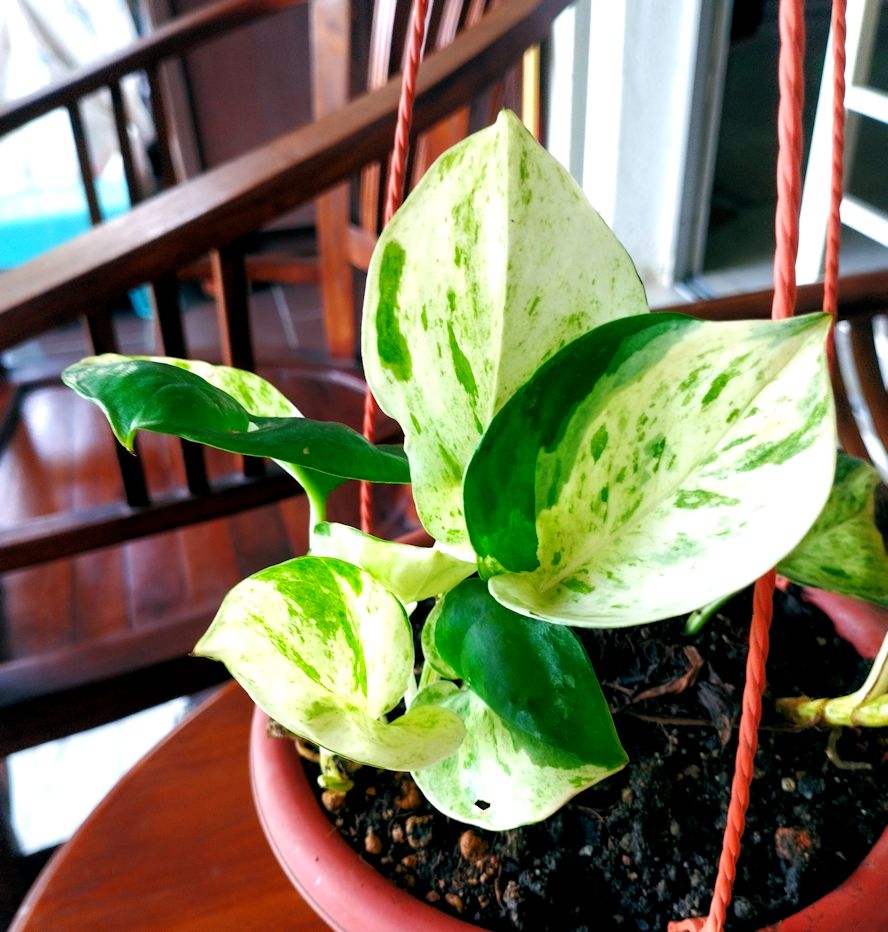
|
First time, I am
handling this plant. Immediately I see the problem. No direct sun and waters
should not touch the leaves etc. |
Callisia reopens -
Pink Panther
|
There are quite a few common names for this plant beside the more commonly used
Baby Tears. More names like Corsican Curse, Corsican Carpet plant, or even Irish
Moss which of course is a Sagina
The plant is native to the northern Mediterranean region Italy and nearby
islands Introduced and cultivated world wide as an ornamental plant.
Baby Tear plants are ground creepers, is a
terrariums. Left
by itself, the plant would spread itself to form a dense mat of lush green leaves. Alternatively if grown in
a pot and the pot being hung up, then the stems would form trails. Combined, the
cluster would be looking like a full head of
hairs from hanging basket. |
Pink Panther #
1

Pink Panther # 2
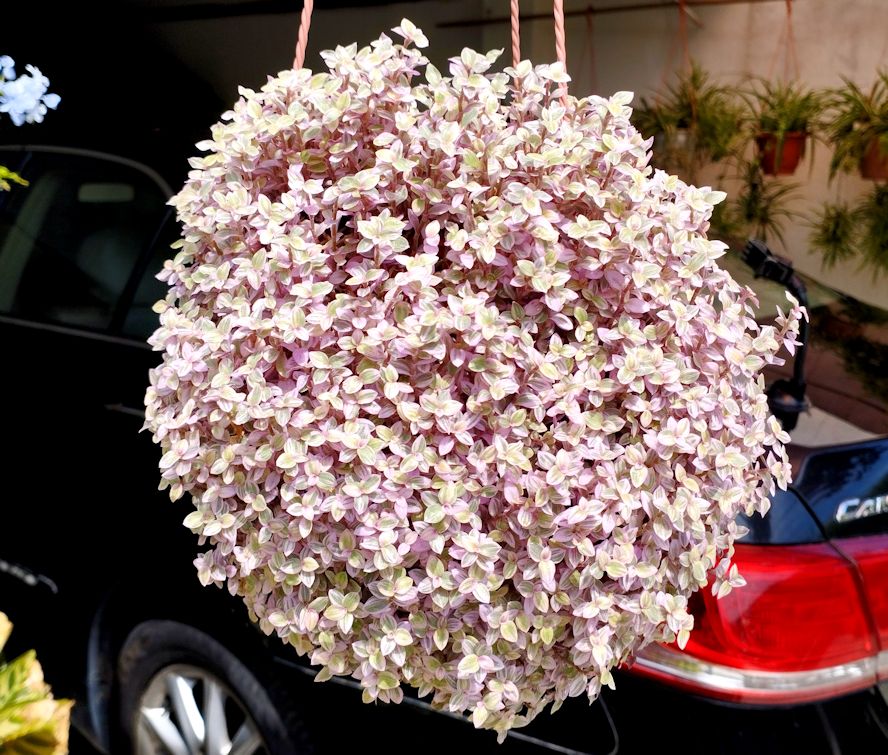
Pink Panther # 3

|
Looks nice and
really quite a beauty. It has its up and down. Now I am getting the hang of
handling it have few pots But for most people, it is not easy to keep the plant
in shape and not tha easy to propagate as well. |
7. Dischidia oiantha Variegated -
White Diamond
|
Dischidia itself is native to the Philippines. The foliage of
this species is elliptic and has a pendant growth habit. There is also a variety
with a variegated leaf margin. Unlike Hoya, the genus Dischidia is poorly known and has not
been studied as closely. A few of the species in widespread cultivation, and can
be kept as houseplants in temperate regions.
Grow Dischidia in
medium to bright filtered light or with lots of artificial light in indoors. Dischidia
also needs high humidity. Mist the plant every day or place the container
on a saucer filled with pebbles and water. The water will evaporate and moisten
the air while the pebbles will hold the sensitive roots out of the water. They
need warm humid conditions
Dischidia oiantha is an epiphytic
climbing plant in the genus. It has bluish silver variegated
leaves, oval, succulent and have white edges which are attractive,
When it flowers, Its
tiny flowers are often overlooked, measuring only about 2 mm in
diameter. The flowers are borne in clusters at the nodes.
Dischidia oiantha
Variegata ‘White Diamond’ is a
trailing epiphyte in the family Apocynaceae. It is native to tropical areas of China,
India and Philippines. Its leaves are fleshy, oval, with white edges. It too blooms with clusters of tiny white flowers located at the nodes of
stem
This is a perfect plant for hanging on walls or from ceiling.
Dischidia in
general do not need fertilizers but it is good to change the planting media
annually
|
White Diamond Creepers #
1
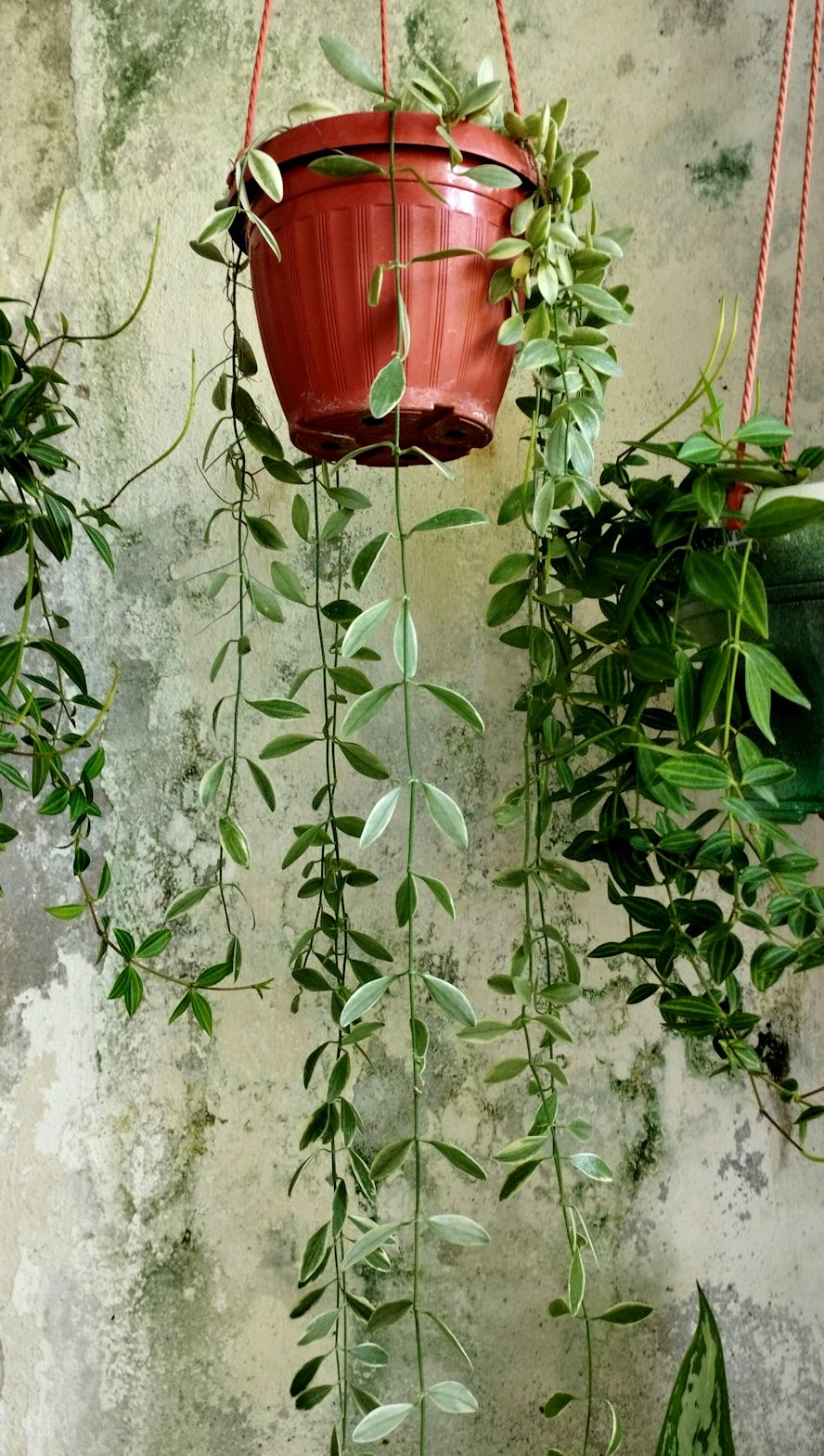
White Diamond Creepers # 2

|
I have seen better
looking pots in other's garden. But for me I am still struggling to have my pots
properly populated. Looking for answers. The tips given on the internet didn't
help that much |
|
Tradescantia
Tradescantia are climbing or
trailing plants which will thrive indoors in good light. They are also known by
other names: spider-lily, cradle-lily, oyster-plant and flowering inch plant.
The stems trail to about 60cm or more. ‘Albovittata’ has green leaves striped
with white above but tinted purple on the underside.
The leaf nodes along its
stems are purportedly one inch apart, hence the common name "Inch Plant". This
plant is also commonly called Wandering Jew.
|
8. Tradescantia blossfeldiana
[cerinthoides]
variegata-
Nanouk
|
Sorry about the
lengthy name. Nanouk can be a tricky plant. It's very prone to water damage on
its leaves, so you'll want to try to avoid splashing them when you water. It
needs very bright light to stay compact, but burns easily in hot sunlight,
especially if water droplets sit on the delicate, fleshy leaves.
It's also prone to
stem rot if the soil is wet for too long. This is a very easy plant to love to
death, as many sad gardeners can attest! Your best bet with this one is to find
a pretty wide ceramic pot that's wide and shallow, to accommodate its spreading,
creeping growth habit. Give it a sunny east window, and forget about it.
Water it when the
soil is dry to help avoid stem and root rot, and pinch it to promote fullness.
Cuttings should be stuck back into the pot to root. Cuttings in our case, broken
off branches is beat kept in water to root and then plant. Chances are very high
and sucess rate - good
|
Tradescantia "Nanouk" # 1
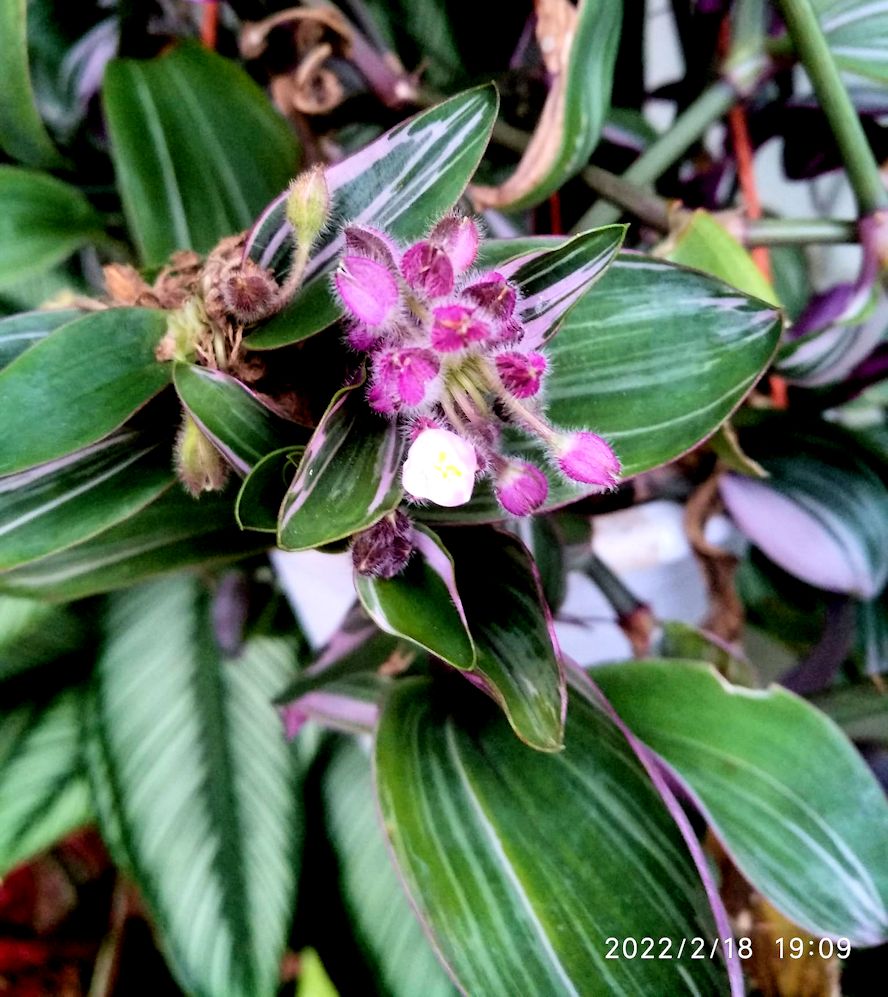
Tradescantia "Nanouk" # 2

|
Oh! I struggled
with this plant. having bought a pot of three baby plants, after half a year. No
growth? Imagine the jokes on me and my frustration. And out of the blue I
changed its locations. It grew very very well! Unbelievable, now I am having so
much broken branches to throw away as I am having too many pots. Down side too,
The colouring and variegation are disappearing many new plants. These are
growing well but the leaves are green in colour. |
9. Transcantia albiflora
albovitatta -
Giant White Inch Plant
|
Tradescantia fluminensis 'Albovittata' is a
cultivar of Tradescantia fluminensis. It is commonly called Giant White Inch
Plant. Tradescantia fluminensis is native from the regions of Brazil to northern
Argentina,
It is an evergreen trailing plant that roots at the nodes as it
grows along the ground, forming an attractive groundcover or hanging plant. It
is a fast grower and can be easily grown indoors in pots or baskets. Giant White
Inch Plant has ovular, fleshy, pointed green and white variegated leaves that
measure up to 2.5 inches long. Its foliage usually grows to 6 inches in length,
but can spread up to two feet wide or more if allowed to do so. In hanging
display, the stems of the Giant White Inch Plant will sprawl downward. Small,
three-petaled, white blooms can appear throughout the year, but flowers
infrequently appear on plants permanently kept indoors.
Tradescantia albiflora 'Albovittata'
prefers soil to dry out between watering but should be watered regularly. Use a
watering device to calculate according to environment. The plant may have some
difficulties thriving an will drop leaves- without ample sunlight. Place it lees
than 3 feet away from window to maximize potential for growth. Select the area
to see how it affects the plant.
Should be repotted after it
doubles it size or once a year. Fresh potting soil has all the nutrients the
plants needs. Dardner shouldn't use fertilizer. The plant get its energy from Sunlight.
it prefer soil. Tradescantia albiflora 'Albovittata' may have difficulty thriving, and will drop
leaves without ample sunlight.
Place it less than 3 feet from a south-facing window to maximize the potential
for growth. Select your region to see how the current weather in your area affects the
placement of Tradescantia albiflora 'Albovittata' in your home
Most potting soils come with ample nutrients which plants use to produce new
growth. By the time your plant has depleted the nutrients in its soil it’s likely grown
enough to need a larger pot anyway. To replenish this plant's nutrients, repot your Tradescantia albiflora 'Albovittata' e;">
So pretty and so easy to propagate. I’d just recommend giving it a haircut every
few weeks to encourage it to grow bushy! |
Giant White
Inch Plant # 1
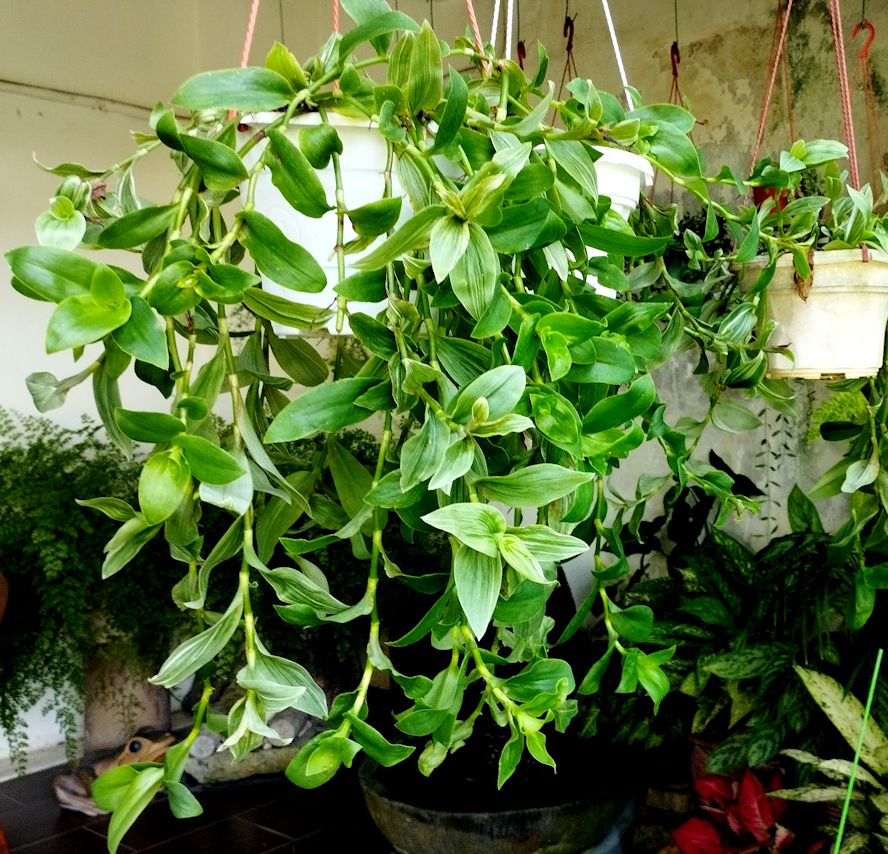
Giant White
Inch Plant # 2

|
Coming from the
same family of plants as the "Nanouk", we are having problem with this plant.
Right now I got them growing but the leaves are loosing the stripes for which
the plant is known for. |
10. Transcantia zebrina -
Wandering Dude - Silver Plus
|
One of the most
common zebrinas, this beautiful cultivar features deep purple tips that age to
silvery green over time. This is an easy one, and shouldn't give gardeners too
much trouble in up keeping it. Cuttings root very easily in soil, and can even
be laid on top of soil and allowed to root themselves.
Extra cuttings were left in pots and ground. Within a week or two, the short
length of cutting stood upright as roots had reached the soil. In no time, the
few cutting gathered them selves as a bush. Nearly every single one rooted, even
after three months as cuttings! It's a very tough plant! |
Tradescantia
Wandering Dude # 1
.jpg)
Tradescantia
Wandering Jew # 1
.jpg)
Tradescantia
Wandering Dude # 3
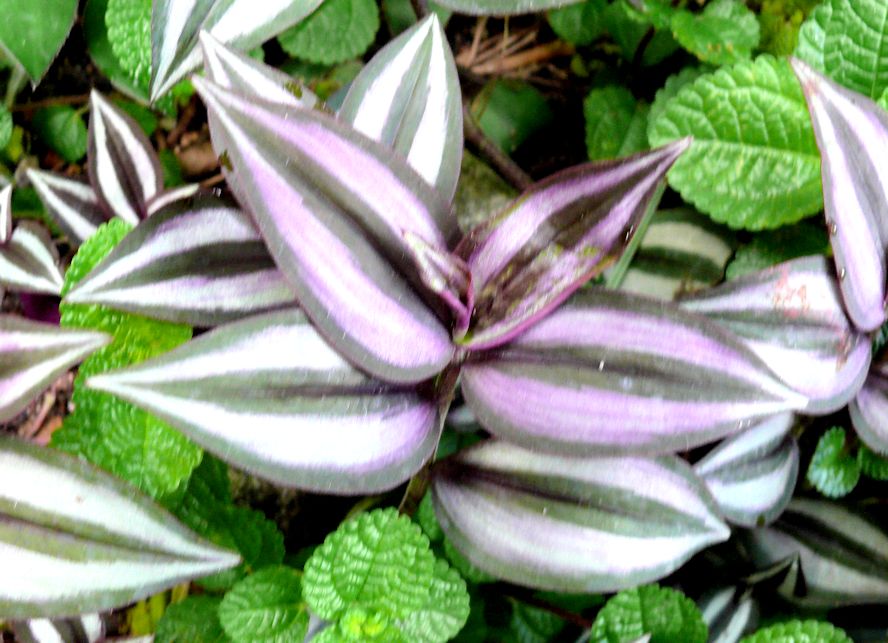
Tradescantia
Wandering Dude # 4

|
This species is
really wild weeds. From the hanging pots, there dying fragments which we cut off
and threw them into a nearby trough. It is now sprouting away like a tiny
jungle. |
11. Chlorophytum comosum -
Spider Plants
|
There are
a variety of spider plants available at many nurseries and garden centres. For
example ;- There is the
Bonnie spider plant grows with leaves that curl and twist, next the variegated
Bonnie offers white-striped leaves. Plus a few especially unique picks include the
Hawaiian variant, with its multicoloured leaves that fade as they age, and the
Zebra grass spider plant that has edges of white around its green leaves.
Spider plants were once highlighted
by NASA for their reported air-purifying ability, though a large amount of
plants would be required to reap any benefits in the home.
The leaves of the plant are green,
striped white and green, and sometimes striped green and bright yellow. Leaves
are long, narrow and thin. They grow best in a hanging basket. It also produces
small white flowers which are mostly star-shaped.
When matured, the spider plants may produce tiny white flowers on long stems, as
well as baby spider plants (offsets) called “pups.” Yes, Spider plants that
begin producing flowers, eventually developing into babies, or spider plant
spiderettes.
The pups look like tiny spiders,
hence the plant’s name!
The best method
for rooting spider plant's spiderettes is by allowing the plantlet to remain
attached to the mother plant. Choose a spiderette and place it in a pot of soil
near the mother plant. Keep this well watered and once it roots, you can cut it
from the mother plant. Alternatively, you can cut off one of the plantlets,
place it in a pot of soil, and water generously. Place the pot in a ventilated
plastic bag and put this in a bright location. Once the spiderette is well
rooted, remove from the bag and grow as usual.
As daylight increases in spring,
This may not always occur, however, as only mature plants with enough stored
energy will produce spiderettes. Spiderettes can be rooted in water or soil, but
will generally yield more favorable results and a stronger root system when
planted in soil. |
Green
Spider Plants # 1
.jpg)
Green
Spider Plants # 2
.jpg)
Green
Spider Plants # 2
.jpg)
|
This stunning
Plant is playing mouse & Catch with me. Some pots I got the Spiderettes
spreading like crazy. In other pots, the plants are not responding to nutrients
at all |
12.
Chlorophytum comosum
‘Vitattum’ - White Spider
Plants
|
The write-up on this white species
Spider Plants is line the paragraph above for the green leaves species. The
style and growth of all Spider plants are identical
So, the variety you are most likely seeing in stores is
with white leaves - called Chlorophytum comosum
‘Vitattum’ (the green edged leaves with a white stripe on the middle), however
there are quite a few more varieties available as mentioned ealier.
This while leaves species are more attractive. It has long,
thin arching leaves that make up a gorgeous rosette. The leaves are green on the
outside with a white center. |
White Spider
plants # 1

White Spider
plants # 2
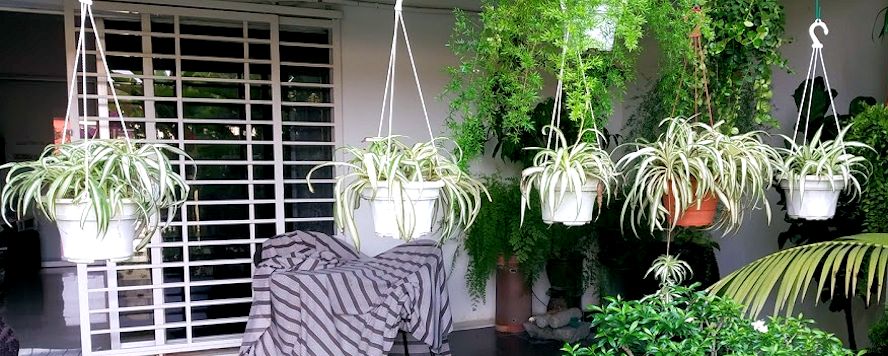
White Spider
plants # 3

White Spider
plants # 4
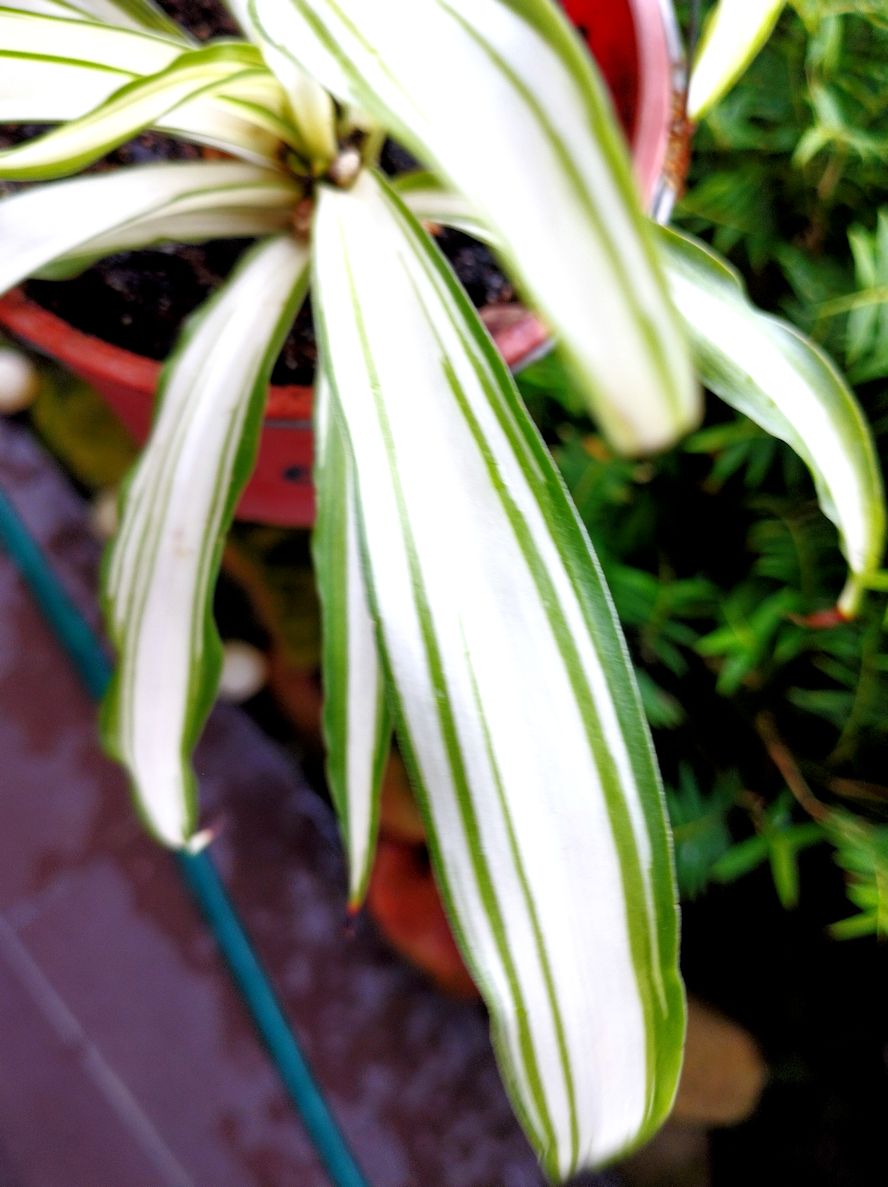
|
I had this plant
since time in memorial, so far I was successful in keeping them alive some
by accident looked well. Like the green counterparts, I am trying to grow the
plant. Meaning control the plant and allow them to grow the way I wanted them to
be. Experiment started. |
13. Peperomia quadrangularis
|
Peperomia quadrangularis is a member of the Piperaceae
family. A small trailing peperomia from Brazil, Panama and Central
America. Our plant was labeled as P. angularis or angulata. But it looks like it
is P. quadrangularis.
A common garden plant, this live
plant is safe to use with animals and are non-toxic to cats and dogs.
Gently hold the stem between your
fingers and you’ll feel it’s four-sided shape – that is where it gets it’s
rather long and hard to pronounce name but trust me it’s easier to grow
Peperomia quadrangularis and luckily it has some simple common names like Beetle
Peperomia or Peperomia Angulata.
The leaves are ovate, dark green and they have golden
veins. The leaves are quite stiff but the stems are very thin and flexible. This peperomia will make a very nice small hanging basket. It also does well in a
terrarium as a small creeping ground cover.
Shade to partial shade, temp. 50 to 95 degrees, 2 to 3 in. tall. Allow to get
dry between wateringsMake sure it does not get too wet
because it will rot easily.
This tiny houseplant is very easy to manage and is often used for decoration in
houses. The plants are compact and occupy a small space wherever you place them.
|
Peperomia Quadrangluris # 1
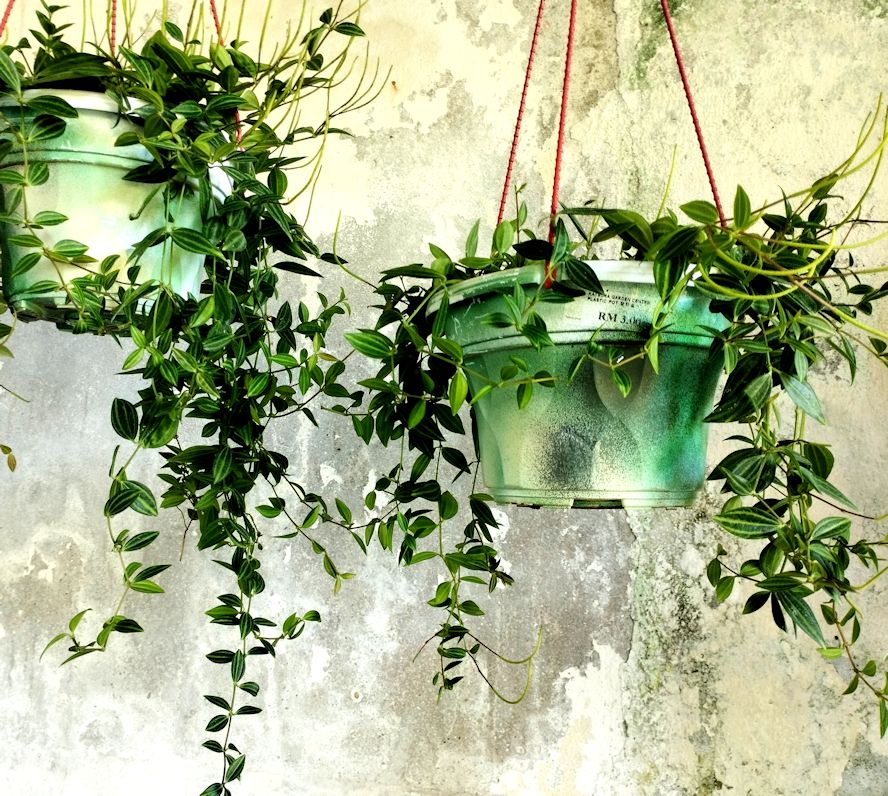
Peperomia
Quadrangluris # 2
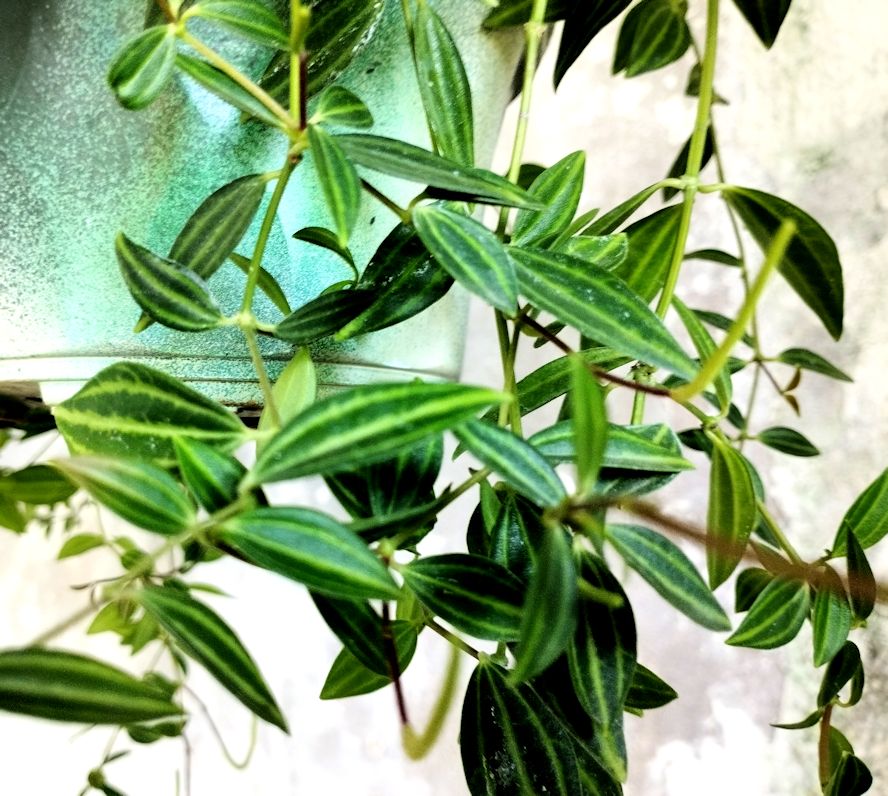
|
It grew very well
the first batch that we separated from the samples bought from the nursery. The
next round, our efforts failed. Don't know why? Now I am in the 3rd round of
efforts, stable but growth is very very slow/ |
14.
Nephrolepis exaltata Variegata -
Variegated Boston Ferns
|
Variegated Boston fern
plant (Nephrolepis exaltata Variegata) - are finely-toothed,
sword-shaped fronds that are variegated green and yellow-gold. It is a
spectacular color groundcover for a woodland area; great in hanging
baskets or containers, for indoors or out.
The attractive glossy ferny pinnately compound
leaves remain green in color with showy gold variegation and tinges
of buttery yellow throughout the year. Neither the flowers nor the
fruit are ornamentally significant. This is a dense herbaceous annual with a shapely
form and gracefully arching foliage. Its relatively fine texture
sets it apart from other garden plants with less refined foliage.
This plant will require occasional maintenance and upkeep, and
should not require much pruning, except when necessary, such as to
remove dieback. Gardeners should be aware of the following
characteristic that may warrant special consideration;
The Fern will grow to be about 24 inches tall at
maturity, with a spread of 24 inches. When grown in masses or used
as a bedding plant, individual plants should be spaced approximately
18 inches apart. Its foliage tends to remain dense right to the
ground, not requiring facer plants in front. Gardeners should
take into consideration that it will perform differently than it
would in its native habitat.
This plant performs well in both full sun and full shade. It does
best in average to evenly moist conditions, but will not tolerate
standing water. It is not particular as to soil pH, but grows best
in rich soils. It is somewhat tolerant of urban pollution. This is a
selected variety of a species not originally from North America. It
can be propagated by division; however, as a cultivated variety, be
aware that it may be subject to certain restrictions or prohibitions
on propagation.
Variegated Boston Fern is a fine choice for the garden, but it is
also a good selection for planting in outdoor containers and hanging
baskets. It can be used either as 'filler' or as a 'thriller' in the
'spiller-thriller-filler' container combination, depending on the
height and form of the other plants used in the container planting.
It is even sizeable enough that it can be grown alone in a suitable
container. Note that when growing plants in outdoor containers and
baskets, they may require more frequent waterings than they would in
the yard or garden.
|
Variegated Boston Fern # 1

Variegated Boston Fern # 2
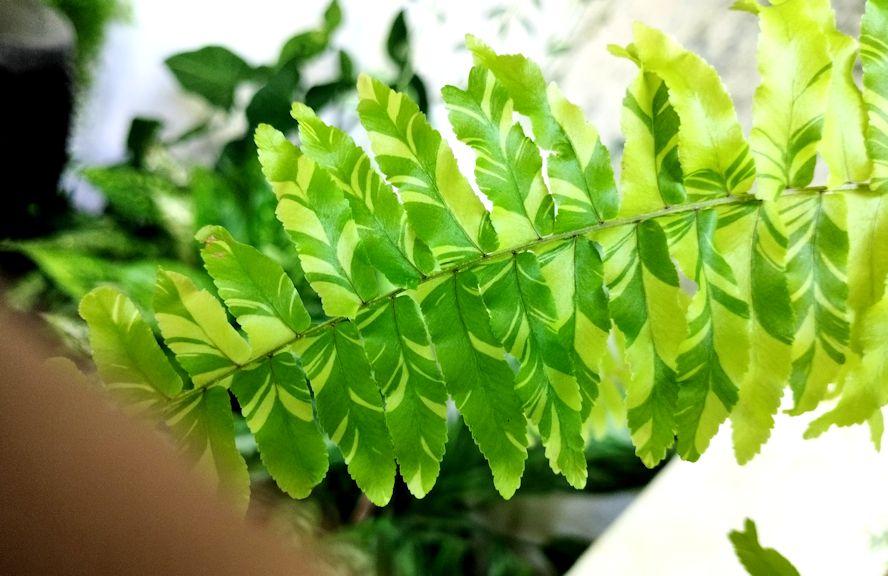
Variegated Boston Fern # 3

|
We are having this
plant for the first time. Separated them into pots plus getting a few saplings
and starting new pots. Let's see! |
15. Sprenger's Asparagus Fern -
Weeds
|
Asparagus aethiopicus, Sprenger's
asparagus, is a plant native to the Cape Provinces and the Northern Provinces of
South Africa.
Often used as an ornamental plant, it is considered an invasive
weed in many locations. It is a rounded
herbaceous perennial that is used in the landscape for its attractive,
fine-textured foliage.
This is a1 to 4 foot-tall plant has true leaves that are
scale-like and inconspicuous. The structures that most refer to as leaves are
actually leaf-like branchlets called chlorophylls. These tiny cladophylls are
linear, flattened structures that are bright green in color. They occur singly
or in groups of 3 or more at a node. The stems of this plant emerge directly
from the ground and become woody and spiny, so be careful when handling this
species. The thorns cause significant irritation to many people that handle the
plant.
Pretty, red, ovoid berries occur on Asparagus densiflorus throughout the
year. Several birds eat and probably distribute the fruit. These fruits follow
tiny, white, flowers that occur in maxillary racemes; the flowers are
inconspicuous for the most part but fragrant.
Seeds germinate in the landscape
and the plant has escaped into natural habitats of host country. It can also
become a weed in your landscape. This needle looking plant is
Sprenger's Asparagus Fern, poisonous to dog |
Sprenger's
Asparagus Fern # 1
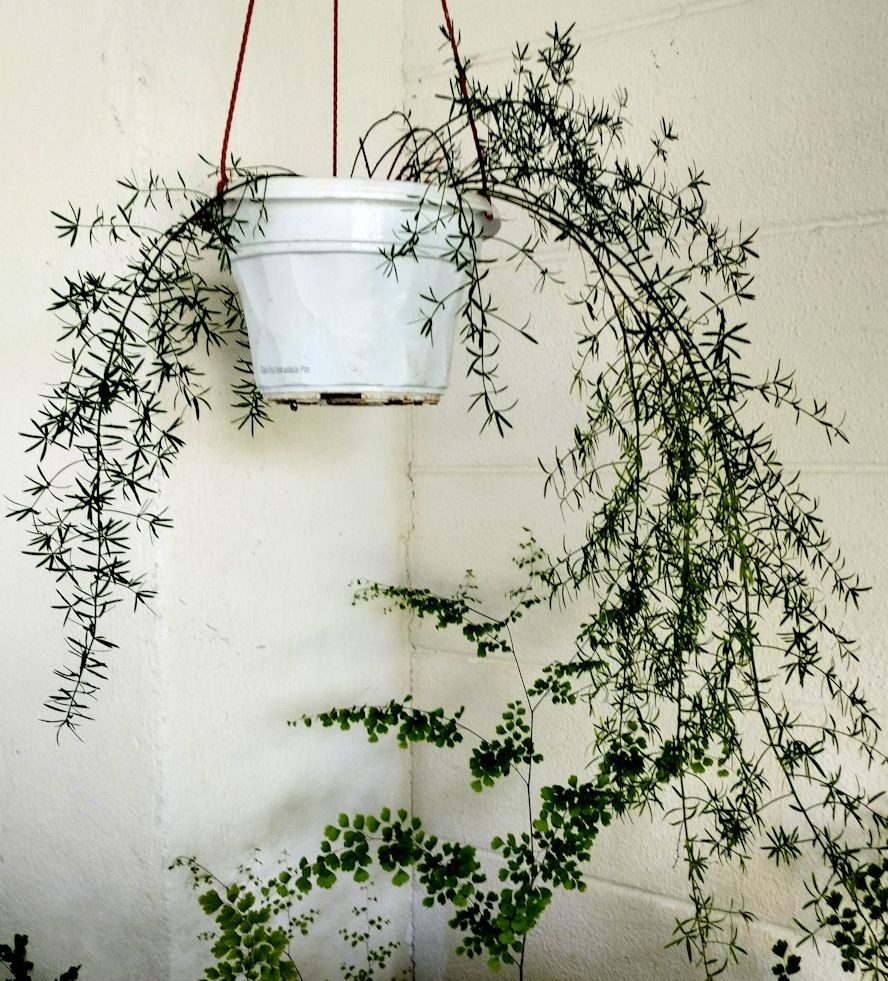
Sprenger's
Asparagus Fern # 2

Sprenger's
Asparagus Fern # 3

|
I have this stunning
picture in my archive. This was the best we ever had from this plant. Now after
years of neglect, with the remnants sample, I am trying to re-enact what I did
so well previously. Good luck |
|
Very happy indeed
that I got this page started. It is exclusively for myself and my own browsing.
First I have got the proper name of plants registered into a page. Next now I
see the potentials of adding on more parches as I move along.
When the page gets
too long. Some contents would move out and becoming an independent page on their
own. Just like growing plants. The topics of garden expands |
|
![]()





















.jpg)
.jpg)


.jpg)
.jpg)
.jpg)










